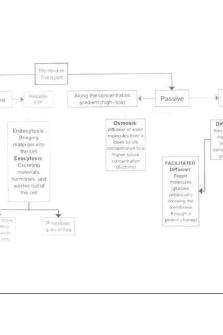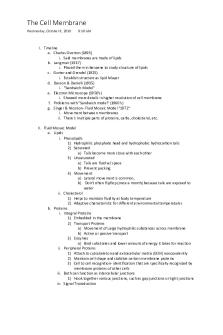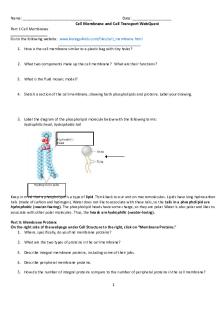Copy of cell membrane and transport notes organizer PDF

| Title | Copy of cell membrane and transport notes organizer |
|---|---|
| Author | Korde Neyland |
| Course | General Biology |
| Institution | University of California Los Angeles |
| Pages | 6 |
| File Size | 394.5 KB |
| File Type | |
| Total Downloads | 10 |
| Total Views | 179 |
Summary
This are great notes that can help on test If you really pay attention and copy down right and go over den...
Description
Name Chan’Tel Morrison Date 10/27/2021 Period 4th
1. Which cell structure is responsible for maintaining homeostasis (a stable, internal environment) within the cell? Cell Membrane
2. Cell walls surround ( plant / animal / all ) cells. 3. The cell membrane is found in ( plant / animal / all ) cells. 4. Describe the overall structure of the cell membrane: The cell membrane is like a phospholipid bilayer which contains two layers of phospholipids with embedded proteins
5. Label the hydrophilic and hydrophobic portions of a phospholipid. The bubble is hydrophilic The legs are hydrophobic
6. Give at least one reason why small molecules are able to easily pass through the phospholipid bilayer of the cell membrane. The push and pull of water
7 . 8 .
The Fluid Mosaic model explains the idea that proteins and other embedded structures “float” within the cell membrane as it flexes and bends. Label the major structures found within the cell membrane.
Carbohydrate Chain
Phospholipid Bilayer
Cholesterol
9. What does it mean to describe the cell membrane as semipermeable? Something that allows certain materials in and out of the cell
10. Complete the following concept map.
Cell Transport Definition:
Passive Transport
Active Transport
Energy Required? no
Energy Required? yes
Materials move:
Materials move:
High � Low
Low � High
( With / Against ) gradient.
( With / Against ) gradient.
Examples: Diffusion, osmosis, Facilitates Diffusion
Examples: Endocytosis and Exocytosis
11. Define diffusion. Diffusion is the movement of small particles from high to low until equilibrium is reached
12. Molecules diffuse until they reach a state of Equilibrium
13. What molecule is moving across a membrane during the process of OSMOSIS? Water
14. Draw a picture of a red blood cell in the three osmotic solutions: Isotonic
Hypertonic
Hypotonic
15.
Complete the t-chart on the three osmotic conditions. Isotonic Solution **Equal amount of solute in and
out of cell.** How does the water move? water moves in and out of cell in equal amounts What happens to the cell? The cell size does not change
Hypertonic Solution Where is the solute HIGH? Outside of the cell
Hypotonic Solution Where is the solute HIGH? Higher concentration of solute inside the cell
How does the water move? Water diffuses out of the cell through osmosis What happens to the cell? Cell shrinks/ shrivels in size
How does the water move? Water diffuses into cell through osmosis What happens to the cell? Cell expands and cann even burst
16. Facilitated diffusion is a type of ( passive / active ) transport. 17. Define facilitated diffusion. Diffusion of larger molecules which must be “helped” through the membrane by traveling through channel proteins and carrier proteins.
18. What is the major difference between endocytosis and exocytosis?
19. Summarize the process of endocytosis.
20. Summarize the process of exocytosis.
21. The ____________________________________ _____________________________________ plays a major role in the release of proteins and other materials through the process of exocytosis.
22. Compare and contrast passive transport and active transport by placing the following terms in the correct location on the venn diagram.
Uses the cell membrane Osmosis
Endocytosis Does not require energy
With the concentration gradient
Low � High
High � Low
Diffusion
Requires the use of energy Facilitated Diffusion
Maintain homeostasis within cell Against the concentration gradient Exocytosis
Transport of materials in and out of cell...
Similar Free PDFs

Membrane Transport Flow Chart
- 1 Pages

Cell Membrane Coloring Worksheet
- 2 Pages

Week 2 Membrane transport lab
- 6 Pages

The Cell Membrane
- 2 Pages

6-cell membrane web quest
- 4 Pages

Chapter 7 HW Membrane Transport
- 1 Pages
Popular Institutions
- Tinajero National High School - Annex
- Politeknik Caltex Riau
- Yokohama City University
- SGT University
- University of Al-Qadisiyah
- Divine Word College of Vigan
- Techniek College Rotterdam
- Universidade de Santiago
- Universiti Teknologi MARA Cawangan Johor Kampus Pasir Gudang
- Poltekkes Kemenkes Yogyakarta
- Baguio City National High School
- Colegio san marcos
- preparatoria uno
- Centro de Bachillerato Tecnológico Industrial y de Servicios No. 107
- Dalian Maritime University
- Quang Trung Secondary School
- Colegio Tecnológico en Informática
- Corporación Regional de Educación Superior
- Grupo CEDVA
- Dar Al Uloom University
- Centro de Estudios Preuniversitarios de la Universidad Nacional de Ingeniería
- 上智大学
- Aakash International School, Nuna Majara
- San Felipe Neri Catholic School
- Kang Chiao International School - New Taipei City
- Misamis Occidental National High School
- Institución Educativa Escuela Normal Juan Ladrilleros
- Kolehiyo ng Pantukan
- Batanes State College
- Instituto Continental
- Sekolah Menengah Kejuruan Kesehatan Kaltara (Tarakan)
- Colegio de La Inmaculada Concepcion - Cebu









